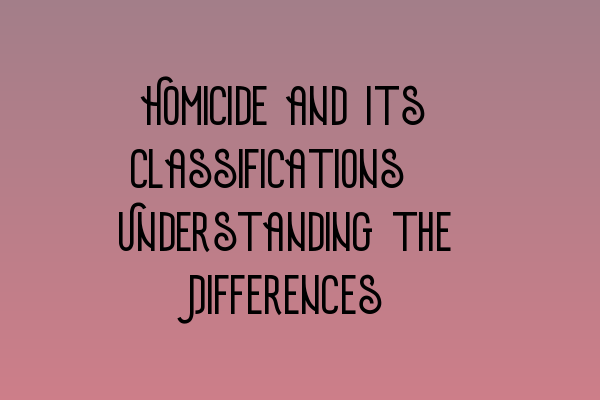Homicide and Its Classifications: Understanding the Differences
Homicide is a severe crime that involves the unlawful killing of one person by another. This act of taking someone’s life is a grave offense that is categorized and classified based on the circumstances surrounding the killing. Understanding the differences between these classifications is crucial for legal professionals in the field of criminal law.
Murder
Murder is one of the most serious forms of homicide, characterized by intentional and premeditated killing. It involves the deliberate act of causing the death of another person with malice aforethought, meaning the intent to cause serious harm or death. To prove murder, the prosecution must establish the presence of both the actus reus (the guilty act) and the mens rea (the guilty mind).
To gain a deeper understanding of murder and its elements, it is recommended to explore our article on SQE 1 Practice Exam Questions. This resource provides comprehensive practice questions to enhance your knowledge and test your understanding of murder in criminal law.
Manslaughter
Manslaughter differs from murder in that the intent to kill is usually absent or less prominent. It is the unintentional killing of another person, often resulting from reckless or negligent behavior. Manslaughter can be categorized into two forms: voluntary manslaughter and involuntary manslaughter.
Voluntary manslaughter occurs when the defendant kills in the heat of the moment, with adequate provocation, which leads to a temporary loss of self-control. This is sometimes referred to as a “crime of passion.” Involuntary manslaughter, on the other hand, arises when the defendant unintentionally causes the victim’s death through reckless or negligent actions.
If you want to delve deeper into the topic of manslaughter and its legal implications, our article on SQE 1 Practice Mocks FLK1 FLK2 offers valuable exam practice material to strengthen your understanding and application of the laws surrounding manslaughter.
Infanticide
Infanticide is a specific category of homicide that involves the killing of a child aged under one year by their mother, who suffers from a disturbed mental state due to childbirth. This offense is recognized as a separate offense, distinct from murder or manslaughter. It takes into account the unique circumstances surrounding a mother’s mental health and the pressures related to childbirth.
Conclusion
Understanding the classifications of homicide is essential for legal professionals working in the criminal law field. The differences between murder, manslaughter, and infanticide lie in the intention, mental state, and circumstances behind the killing. Keeping abreast of these classifications ensures a robust understanding of criminal law and its application.
For further resources on criminal law, we recommend exploring our articles on SQE 2 Preparation Courses and SQE 1 Preparation Courses. These courses are designed to provide comprehensive knowledge and practical skills to aspiring legal professionals.
To stay updated with the latest SRA SQE exam dates and important information, please refer to our article on SRA SQE Exam Dates. It’s crucial to stay informed and be aware of the examination schedules and requirements.
By understanding the various classifications of homicide and staying well-versed in criminal law, legal professionals can effectively navigate the complexities of these cases and contribute to a fair and just legal system.
